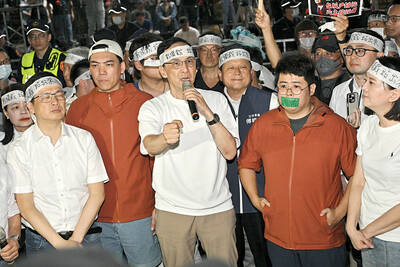Rush Hour 3, the junky, clunky, grimly unfunny follow-up to the marginally better Rush Hour 2, and the significantly finer Rush Hour, isn't the worst movie of the summer. But it's an enervating bummer nonetheless, largely because it shows so little respect for its two likable stars and its audience. Once again Jackie Chan (成龍) and Chris Tucker, playing seriously unlikely detectives, bumble and slog through muddled setups, graceless action, crude jokes and even cruder stereotypes, sacrificing themselves on the altar of the director Brett Ratner's vulgar success.
The arc of Ratner's career can be summed up entirely with numbers, namely the US$247,538,093 that Rush Hour raked into theaters worldwide; the US$328,883,178 that Rush Hour 2, made across the globe; and the mind-boggling (especially if you saw the movie) US$453,796,824 earned, again worldwide, by X Men: The Last Stand. These figures, from Variety, don't include DVD revenue, cable sales and the like, but you get the big tautological picture: Ratner has a gift for making products that companies can sell to the public, which is why he makes products. Even so, given the anonymity of these products, the credit "A Brett Ratner Film" seems largely ceremonial.
There's nothing new about any of this, yet it does bear repeating every so often, even in a movie review. Like a lot of big-ticket productions Rush Hour 3 flooded into US theater in August (gobbling up more than 3,700 of the nation's approximately 38,000 screens) and, because of its ubiquity and its brawny advertising muscle, pulled in a sizable chunk of change. Bad reviews won't make a lick of difference to its box office, though franchise fatigue might. Chan's and Tucker's star power has waned in the six years since Rush Hour 2.

PHOTO: COURTESY OF WARNER BROTHERS
Part of the reason I've strayed from discussing Rush Hour 3 is that there's not much to say about the actual movie. It's a generically crummy action flick. It's ugly. It's noisy. It's stupid. And unlike, say, Transformers, which sells militarism alongside children's toys, it doesn't raise hackles, much less blood pressure. Thus, as an object, Rush Hour 3 offers precious little of interest, although it does take a special kind of talent to make Paris, where some of the story takes place, look this uninviting. There, rather depressingly, Roman Polanski shows up wearing a mustache and a smirk to harass Chan's and Tucker's characters, who are globetrotting after some villains. Max von Sydow also pops up for a few scenes, a reminder that Ingmar Bergman really is dead.
Chan and Tucker don't get to wiggle off the hook entirely. But people have to make a living, even movie stars, and there are limited opportunities for an aging Hong Kong martial-arts giant and an eccentrically talented black comic actor. Given how much pleasure both have provided over the years, especially Chan, here's hoping they were paid by the truckload.

In the March 9 edition of the Taipei Times a piece by Ninon Godefroy ran with the headine “The quiet, gentle rhythm of Taiwan.” It started with the line “Taiwan is a small, humble place. There is no Eiffel Tower, no pyramids — no singular attraction that draws the world’s attention.” I laughed out loud at that. This was out of no disrespect for the author or the piece, which made some interesting analogies and good points about how both Din Tai Fung’s and Taiwan Semiconductor Manufacturing Co’s (TSMC, 台積電) meticulous attention to detail and quality are not quite up to

April 21 to April 27 Hsieh Er’s (謝娥) political fortunes were rising fast after she got out of jail and joined the Chinese Nationalist Party (KMT) in December 1945. Not only did she hold key positions in various committees, she was elected the only woman on the Taipei City Council and headed to Nanjing in 1946 as the sole Taiwanese female representative to the National Constituent Assembly. With the support of first lady Soong May-ling (宋美齡), she started the Taipei Women’s Association and Taiwan Provincial Women’s Association, where she

Chinese Nationalist Party (KMT) Chairman Eric Chu (朱立倫) hatched a bold plan to charge forward and seize the initiative when he held a protest in front of the Taipei City Prosecutors’ Office. Though risky, because illegal, its success would help tackle at least six problems facing both himself and the KMT. What he did not see coming was Taipei Mayor Chiang Wan-an (將萬安) tripping him up out of the gate. In spite of Chu being the most consequential and successful KMT chairman since the early 2010s — arguably saving the party from financial ruin and restoring its electoral viability —

It is one of the more remarkable facts of Taiwan history that it was never occupied or claimed by any of the numerous kingdoms of southern China — Han or otherwise — that lay just across the water from it. None of their brilliant ministers ever discovered that Taiwan was a “core interest” of the state whose annexation was “inevitable.” As Paul Kua notes in an excellent monograph laying out how the Portuguese gave Taiwan the name “Formosa,” the first Europeans to express an interest in occupying Taiwan were the Spanish. Tonio Andrade in his seminal work, How Taiwan Became Chinese,